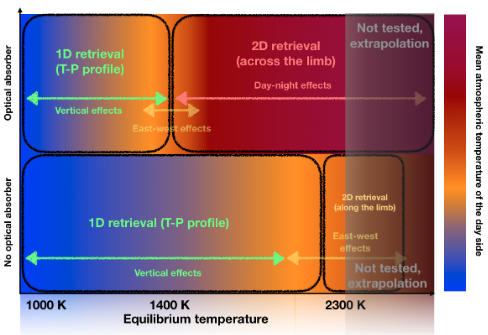Evolution of the biases in retrieved atmospheric composition of hot Jupiters
- 1Laboratoire d'astrophysique de Bordeaux, Univ. Bordeaux, CNRS, B18N, allee Geoffroy Saint-Hilaire, 33615 Pessac, France (william.pluriel@u-bordeaux.fr)
- 2Department of Physics, Oxford University, OX1 2JD, United Kingdom (vivien.parmentier@physics.ox.ac.uk)
Transmission spectroscopy provides us with information on the atmospheric properties at the limb, which is often intuitively assumed to be a narrow annulus around the planet. This is why all existing retrieval algorithms used so far to constrain the atmospheric composition from data rely either on i) a single 1D forward model, thus assuming a uniform limb or ii) a linear combination of 1D models to account for heterogeneities between different regions of the limb (e.g. east vs. west). Even full three-dimensional atmospheric models (GCMs) commonly use only the atmospheric
columns at the terminator to predict the observable transmission spectrum for a given simulation.
Here, we will present numerical experiment from hot Jupiters to ultra hot Jupiters which demonstrate that the region probed in transmission actually extends significantly toward the day and night sides of the planet and that, as a result, the real transmission spectrum computed from a GCM simulation with our fully 3D radiative transfer differs significantly from results obtained with the usual assumptions, especially for the hottest atmospheres. This comes from the fact that the terminator of hot, synchronously rotating planets is a region exhibiting sharp thermal and compositional gradients.

Fig 1: Sum up of the different geometry required in retrievals code to avoid biases according to the equilibrium temperature ofthe planet and the presence or the absence of optical absorber. 1D retrieval model appears to be correct for planets with equilibrium temperature lower than 1400 K when optical absorber (such as TiO, VO, Na, K, etc) are present in the atmosphere. They are howeverbiased above this limit where 2D retrieval code are mandatory.
Using realistic hot exo-atmospheres from GCM model SPARC/MIT, we will demonstrate how this effect can lead to strong biases is the temperature and abundances retrieved from actual data biases that will need to be addressed and corrected for if we want to be able to make robust inferences from future JWST and ARIEL data. We will determine a global limit where the biases due the 1D hypothesis of retrieval model start to be negligible. We have also established a hierarchy of the different 3D effects (vertical, horizontal along and/or across the limb) in order to be able to chosse the right tool to break down the biases (see Fig. 1). We will finally present our new tool, a 2D version of TauREx, which is designed to unravel these biases.
How to cite: Pluriel, W., Leconte, J., Zingalès, T., Falco, A., and Parmentier, V.: Evolution of the biases in retrieved atmospheric composition of hot Jupiters, European Planetary Science Congress 2021, online, 13–24 Sep 2021, EPSC2021-5, https://doi.org/10.5194/epsc2021-5, 2021.

